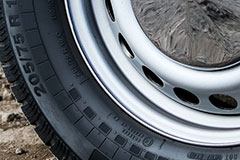How to Determine the Age of a Tire - Vol.354
Who would have thought that determining the age of a tire can be as tricky as online dating? Just the age alone is not indicative of the appearance and just the appearance alone is not indicative of the age. You have to determine both the age and the appearance of a tire to correctly arrive at its true age.

The Tire's Date Code
Determining a tire's year of manufacture is the easy part, as long as you know where to look for. There is something called the DOT code printed on the wall of a tire. It contains specific information about tire, including the week and year of manufacture, as required by the US National Highway Traffic Safety Administration (NHTSA). NHTSA is under the Department of Transportation (DOT), and that's why it's known as the DOT code.
If you can't find the DOT code on the outer wall, then it must have been printed on the inner wall. However, new regulation is such that DOT codes must be printed on both walls.
If you happen to live outside of the US, you might start to worry right now that you won't be able to find DOT codes on your tires. Don't worry, DOT codes can be found on all tires made by established tire manufacturers, from the most well-known to economy and specialty tire brands. The world's largest road network can be found in the US, estimated to exceed 6.58 million km. It's followed by China and India duking it out for second and third places, both at about one-third shorter.
The presence of the DOT code indicates that the tire was manufactured to meet all US DOT standards. The first three digits are "DOT". The next two digits is the plant code that shows which factory the tire was made in, followed by two digits indicating the tire size, followed by a separate group of digits that correspond to the tire brand. Note that each digit can be a number or alphabet.
Coming up next is the last four digits ? and this is the date code. The first two digits indicate the week in which the tire was made, and the last two digits indicate the year. So the last four digits of "1116" would indicate that the tire was made on the 11th week of 2016.
The Tire's Appearance
If you come across a tire with three-digit date code (instead of four-digit), do not buy that tire, or if you own that tire, replace it immediately. Tires made before the year 2000 contain only three-digit date codes.
Old tires are a road hazard. Tires marketed as high-mileage contain additives to keep the rubber in good shape, but even for these tires, the manufacturers only rate them to last 10 years. This is because rubber deteriorates over time. A rubber band left outdoors for the whole summer is going to lose its elasticity and maybe even begin to break up. The same applies to the rubber compound of tires. When the threads begin to break up, they will separate from the steel belt in the body of the tire. What's more, an old tire is more likely to fail catastrophically when it's under the highest stress ? which is usually when you're driving fast.
As mentioned earlier, the age alone does not tell the full story about a tire. For that you'll have to inspect the appearance of the threads as well. If the threads are worn through on any area of the tire, it'd be time to replace it. Tires that are worn unevenly indicate that the car owner has neglected to rotate the tires and keep the wheels in alignment.
A two-year-old tire can potentially see such rough use that it's almost worthless, while a 15-year-old tire is just as worthless even if it looks brand new. To evaluate, you must utilize both the date code and the appearance of the tire.